作为亚洲东部一个古老的陆块,塔里木克拉通被认为是罗迪尼亚和冈瓦纳等超大陆的重要组成部分(Hoffman,1991;Li et al., 2008;Evans,2009;Wen et al., 2013)。塔里木克拉通北缘存在大量的新元古代中-晚期广泛而多样化的岩浆记录,包括超基性—基性侵入岩、双峰式侵入杂岩、基性岩墙群、双峰式火山岩以及大量的花岗岩类(Xu et al., 2005;Zhang et al., 2007;邓兴梁等,2008;Lu et al., 2008;Zhu et al., 2008;Zhang et al., 2009;胡霭琴等,2010;Long et al., 2011;Zhang et al., 2011;Zhu et al., 2011;Ge et al., 2012;Zhang et al., 2012,2013;Zhao and Cawood, 2012;Ge et al., 2014;张传林等,2014),目前最为普遍的观点认为这些岩石是与Rodinia超大陆裂解有关的多期地幔柱活动和大陆裂谷作用的产物(Xu et al., 2005;Zhang et al., 2007;Lu et al., 2008;Xu et al., 2009;Zhang et al., 2009;胡霭琴等,2010;Long et al., 2011;Shu et al., 2011;Zhang et al., 2013)。然而He et al.(2012)对库鲁克塔格地区新元古代麻粒岩的研究,得到820~790Ma的变质年龄,指出塔里木在新元古时期位于Rodinia超大陆外围,认为这一变质年龄与Rodinia超大陆聚合有关,并认为聚合过程类似于安第斯型造山模式。张健等(2014)对阿克苏蓝片岩碎屑锆石的分析,将阿克苏蓝片岩相变质的时间严格限定为820~760Ma,认为阿克苏蓝片岩地体是塔里木早前寒武纪基底之上发育起来的大陆边缘岩浆弧。He et al.(2014a,2014b)通过对库鲁克塔格南华系和阿克苏南华系碎屑锆石的分析,认为新元古代中-晚期的锆石年代记录与环罗迪尼亚大洋俯冲系统有关。Ge et al.(2014)通过对库鲁克塔格西段库尔勒地区新元古—古生代花岗岩类的研究,指出塔里木北缘目前缺乏地幔柱作用的直接物质证据(如科马提岩、高镁玄武岩、OIB、溢流玄武岩等),并提出塔里木克拉通北缘存在新元古—古生代(950~300Ma)长期的俯冲—增生造山作用。因此对于塔里木北缘新元古代中期的构造背景仍需进一步讨论。
研究区位于塔里木北缘库鲁克塔格,前人资料表明库鲁克塔格北塞纳尔塔格组为一套碳酸盐岩沉积,无火山岩记录,作者在兴地塔格阿匐口地区进行的 1︰5万区域地质调查工作中,在北塞纳尔塔格组顶部白云岩之上发现了蚀变流纹岩及少量的流纹质角砾岩,火山岩总厚度达400m。 本文利用高精度LA-(MC)-ICP-MS锆石U-Pb测年及Hf同位素分析手段,对蚀变流纹岩进行锆石U-Pb测年及Hf同位素组成分析,综合已发表资料并结合区域内大量的地质事实,讨论其成因及构造背景,为塔里木克拉通新元古代中-晚期地质演化提供新的依据。
1 区域地质概况近东西向延伸的库鲁克塔格处于塔里木地块北缘和天山造山系的结合部位(图 1a),是塔里木板块基底出露最完好的地区之一,以北部的辛格尔断裂及南部的兴地断裂为界,这两条断裂近东西向绵延数百公里(Wu et al., 2014)。库鲁克塔格由大面积前南华纪变质、褶皱变形的基底岩系和变质、变形微弱的震旦系和古生界盖层所组成,呈现克拉通典型的双层结构(冯本智等,1995)。区内最古老的岩石是太古代—古元古代早期的TTG花岗片麻岩以及表壳岩(Hu et al., 2000;Guo et al., 2005;Lu et al., 2008;Shu et al., 2011;Long et al., 2011)。出露的前寒武纪地层包括新太古宇拖格杂岩、古元古界兴地塔格群和中元古界杨吉布拉克群、爱尔基干群及新元古界青白口系帕尔岗塔格群。青白口系帕尔刚塔格群为一套浅变质浅海相碎屑岩和碳酸盐岩沉积,其下部与蓟县系爱尔基干群整合或断层接触,上部被南华系盖层角度不整合覆盖。南华系主要为粗碎屑岩、冰碛岩,其下部有数百米厚的中基性火山岩,自下而上分为贝义西组、照壁山组、阿勒通沟组和特瑞艾肯组(蔡土赐,1999)。
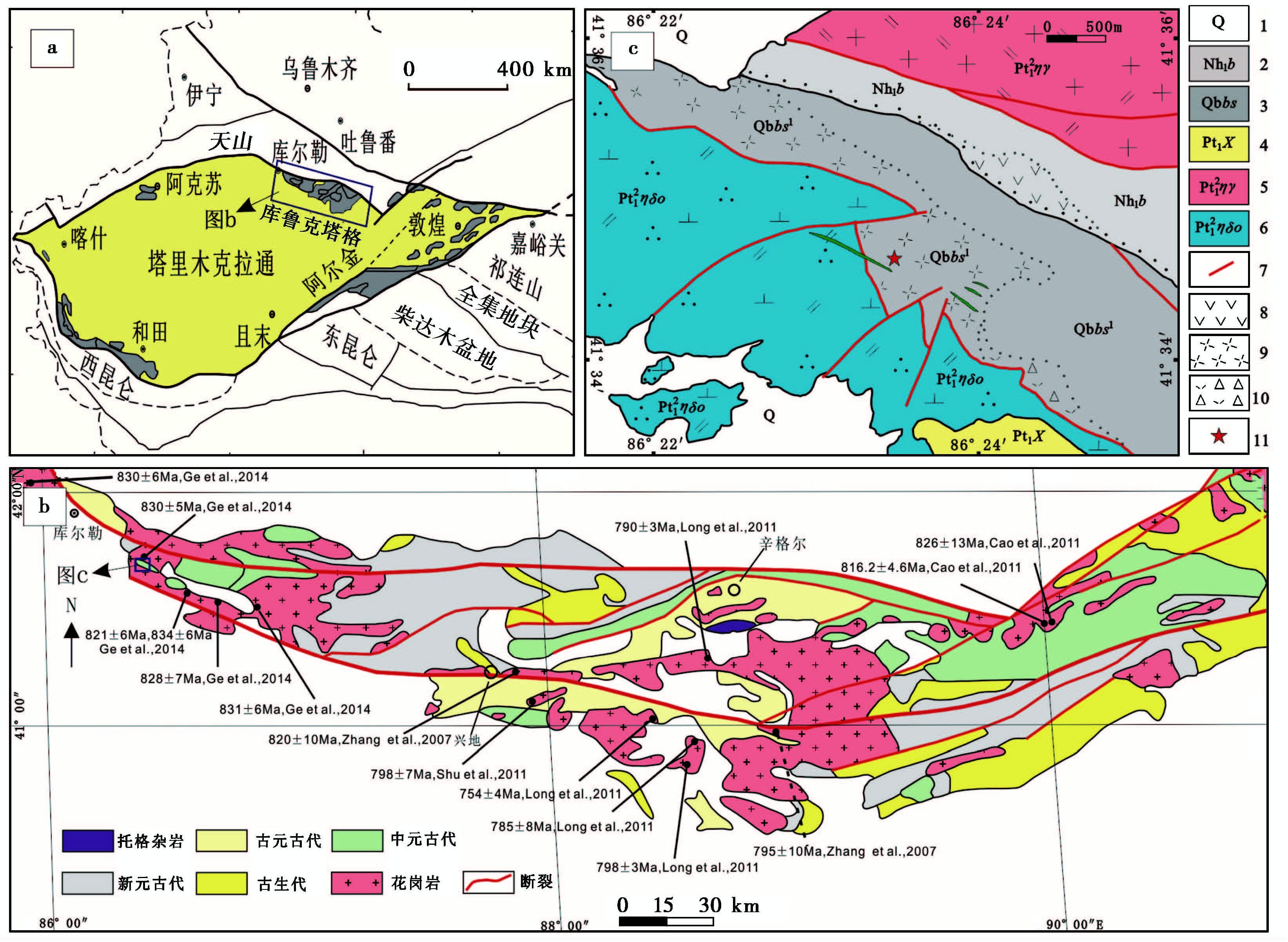
|
图1 研究区地质图 a. 塔里木克拉通及邻区构造略图;b. 库鲁克塔格地质概况及前人数据分布位置(底图据Long et al., 2011;花岗岩数据据Zhang et al., 2007;Cao et al., 2011;Long et al., 2011;Shu et al., 2011;Ge et al., 2014);c. 研究区地质简图;1. 第四系;2. 南华系贝义西组;3. 青白口系北塞纳尔塔格组;4. 古元古界兴地塔格群;5. 古元古代晚期二长花岗岩;6. 古元古代晚期石英二长闪长岩;7. 断裂;8. 玄武岩;9. 蚀变流纹岩;10. 流纹质角砾岩;11. 采样位置 Fig.1 Geological map of the study area |
区内侵入岩分布广泛,以辛格尔断裂为界,断裂南部主要分布前寒武纪侵入岩,北部以古生代侵入岩为主。前寒武纪侵入岩以新元古代中期花岗岩为主(图 1b),这些花岗岩多表现出埃达克岩的地球化学特征(Long et al., 2011;Zhang et al., 2012);古生代侵入体同样以花岗岩为主,时代从奥陶到泥盆纪均有分布,为高钾钙碱性 Ⅰ 型花岗岩,具板块汇聚边缘火山弧花岗岩的地球化学特征(郭瑞清等,2013;贾晓亮等,2013;尼加提等,2013)。
火山岩位于库尔勒市东南部25km西山口一带,产于青白口系北塞纳尔塔格组顶部(图 1c),出露岩石主要为蚀变流纹岩(图 2a)、流纹质角砾岩(图 2b),两者呈相变接触。蚀变流纹岩与北塞纳尔塔格组白云岩为整合接触,与古元古代石英二长闪长岩为断层接触,并被近东西向展布的灰绿玢岩岩脉切穿。其风化色为灰黑—灰白色,新鲜面为灰绿色,镜下特征为斑状—基质微晶结构(图 2c、图 2d)。斑晶为斜长石、石英、黑云母;基质为斜长石、钾长石和石英。岩石蚀变明显,蚀变矿物为绢云母、方解石、绿泥石;副矿物为磁铁矿、锆石、磷灰石。对蚀变流纹岩进行同位素及地球化学样品采集,采样坐标为北纬41°36′44.20″、东经 86°23′27.30″。
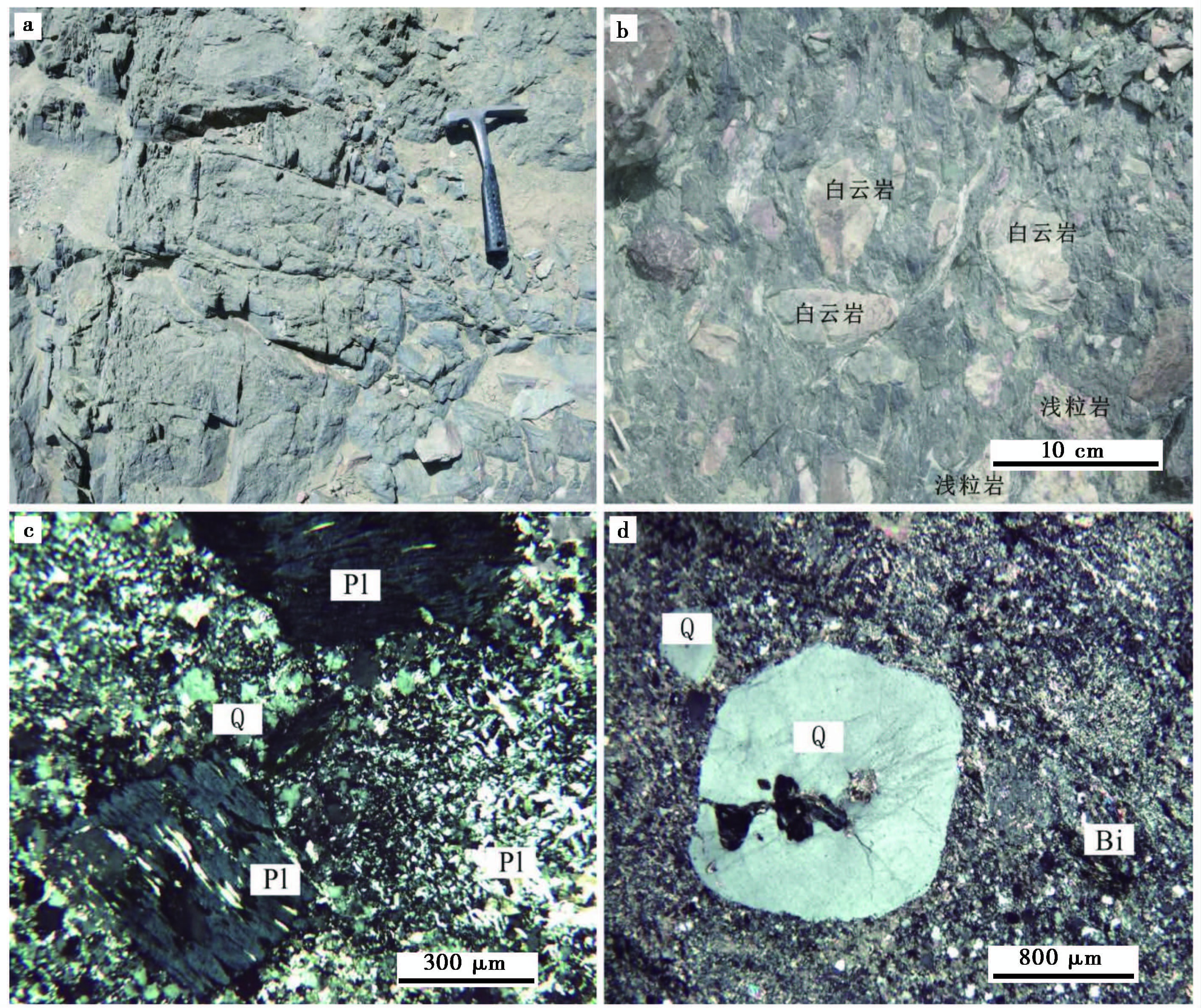
|
图2 蚀变流纹岩野外及镜下特征 a. 蚀变流纹岩野外特征;b. 流纹质角砾岩野外特征;c、d. 蚀变流纹岩镜下特征;Pl. 斜长石;Q.石英;Bi. 黑云母 Fig.2 Field and photomicrograph of metarhyolite |
样品的锆石分选由廊坊地源矿物测试分选公司完成,锆石制靶、阴极发光(CL)图像采集由北京锆年领航科技有限公司完成,锆石LA-ICP-MS U-Pb测年在天津地质调查中心实验室完成。利用193nmFX激光器对锆石进行剥蚀,激光斑束直径为35μm,频率为10Hz,采用He作为激光剥蚀物质的载气,送入Neptune,利用动态变焦扩大色散使质量分数相差很大的U、Pb同位素可以同时接收,进行U-Pb同位素测定(李怀坤等,2009)。使用标准锆石GJ-1为同位素组成的外标锆石,测试数据的误差为2σ。用Andersen(2002)的方法进行同位素比值校正,以扣除普通Pb的影响。U-Pb表面年龄采用ICPMSDataCal96(Liu et al., 2010)程序进行处理,年龄计算及成图采用Isoplot(Ludwig,2003)完成。
在锆石U-Pb定年的基础上,对锆石微区同位素进行测定。锆石原位Lu-Hf同位素测试是在西北大学大陆动力学国家重点实验室进行,在英国Nu公司生产的Nu Plasma HR多接收器等离子体质谱仪上完成,激光剥蚀系统为德国MicroLas公司生产的GeoLas200M。激光剥蚀的脉冲频率为10 Hz,激光束直径为35μm,能量密度为10 J/cm2,剥蚀时间约为50 s。测定时使用锆石国际标样MON-1、91500、GJ-1作为参考物质,相关仪器运行条件及详细分析流程见侯可军等(2007)。锆石原位Lu-Hf同位素测定用176Lu/175Lu=0.026 69和176Yb/172Yb=0.588 6进行同量异位干扰校正计算测定样品的176Lu/177 Hf和176 Hf/177 Hf比值(Chu et al., 2002)。εHf(t)的计算采用176Lu衰变常数为1.867×10-11a(Albarède et al., 2006),球粒陨石现今的176 Hf/177 Hf=0.282 785、176Lu/177 Hf=0.033 6(Bouvier et al., 2008);Hf亏损地幔模式年龄(TDM)的计算采用现今的亏损地幔176 Hf/177 Hf=0.283 25和176Lu/177 Hf=0.038 4(Griffin et al., 2000)。Hf同位素单阶段模式年龄TDM 以亏损地幔为参考计算。两阶段Hf模式年龄(TDM2)计算时,平均地壳的176 Lu/177 Hf比值为0.015(Rudnick and Gao, 2003)。
3 岩石地球化学特征岩石主量及微量地球化学数据见 表 1,岩石烧失量LOI较高(4.72~5.14),指示样品普遍发生了热液蚀变,因此Ba、Rb、K、Na等活动性元素不宜用来进行相关解释和判别。在蚀变过程中,一般认为高场强元素(如Nb、Ta、Zr、Hf)、相容元素(如Cr、Co、Ni等)和稀土元素受到的影响较小,可用来讨论蚀变岩石的类型和成因(Hastie et al., 2007)。蚀变流纹岩具一致的地球化学组成,SiO2的含量为63.57%~64.57%。使用SiO2-Zr/TiO2图解(图略)进行岩石学定名,所有样品均落在流纹英安岩—英安岩区,落入钙碱性系列范围内;所有样品具高的K2O含量(2.97%~3.3%)以及K2O/Na2O比值(0.98~1.25),表明它们是髙钾钙碱性熔岩。岩石的A/CNK为1.02~1.15,属过铝质岩石。
| 表1 蚀变流纹岩主量元素/%和微量元素/×10-6 分析结果 Table 1 Major/% and trace element/×10-6 compositions of the metarhyolite |
蚀变流纹岩 Σ REE 为105.08×10-6~117.74×10-6,均大于球粒陨石稀土元素总量。LREE/HREE为23.24~25.76,(La/Yb)N为43.87~59.18,反映北塞纳尔塔格组火山岩具轻稀土富集、重稀土强烈亏损的特点,样品显示正的Eu异常,δEu为1.21~1.23,类似于埃达克岩平均值(Martin et al., 2005),在稀土元素分配模式图(图 3a)中均表现为Eu正异常的陡倾斜特征。流纹岩原始地幔标准化蛛网图(图 3b)具有一致的变化趋势,表现为Rb、Ba、K等大离子亲石元素相对富集,明显亏损Nb、Ta、P、Ti等高场强元素。此外蚀变流纹岩具高的Sr(377×10-6~426×10-6),低的Y(5×10-6~5.3×10-6)、Yb(0.36×10-6~0.43×10-6)组分,以及高的Sr/Y比值(75.4~80.6)的特征,高于平均的高硅埃达克岩(Sr/Y=57;Martin et al., 2005),与库鲁克塔格中部埃达克质花岗岩类特征一致(Zhang et al., 2007;Long et al., 2011)。

|
图3 蚀变流纹岩稀土元素球粒陨石标准化配分图(a)及微量元素原始地幔标准化蛛网图(b) 库鲁克塔格中部埃达克质花岗岩数据引自Zhang et al., 2007;Long et al., 2011 Fig.3 Chondrite-normalized REE patterns(a)and primitive mantle-normalized trace element spidergrams(b)diagrams of the metarhyolite |
对蚀变流纹岩(D4817.1)锆石进行LA-ICP-MS分析,U-Pb同位素组成及年龄分析结果见 表 2。流纹岩中锆石为长柱状—不规则长柱状,颗粒长径为90~220μm,长宽比为2︰1~3︰1。 阴极发光图像上,锆石呈灰色—灰白色,少数锆石出现继承性核,多数锆石发育明显的岩浆振荡环带(图 4)。
| 表2 蚀变流纹岩LA-ICP-MS锆石U-Pb同位素测试结果 Table 2 La-ICP-MS zircon U-Pb isotopic analysis of the metarhyolite |

|
图4 蚀变流纹岩阴极发光图像 Fig.4 CL images of ziroon from metarhyolite |
这些锆石的Th、U含量分别为6×10-6~53×10-6和48×10-6~329×10-6,Th/U比值为0.05~0.22,多数锆石Th/U比值大于0.1而小于0.4,少数锆石的Th/U比值小于0.1,介于变质成因锆石与岩浆成因锆石的Th/U比值范围之间(Möller et al., 2003),鉴于锆石的Th/U比值不能很有效地鉴别锆石成因(吴元保等,2004),很多岩浆成因锆石的Th/U比值非常低,甚至可以低于0.1(Hidaka et al., 2002;吴元保等,2002;Tomaschek et al., 2003),蚀变流纹岩中多数锆石发育明显的岩浆振荡环带,说明其为岩浆锆石。样品共测得20个点位,在谐和曲线上(图 5),19个年龄数据成群分布,206 Pb/238 U年龄加权平均值为841.0±1.4Ma(MSWD=0.42),代表其喷发年龄。
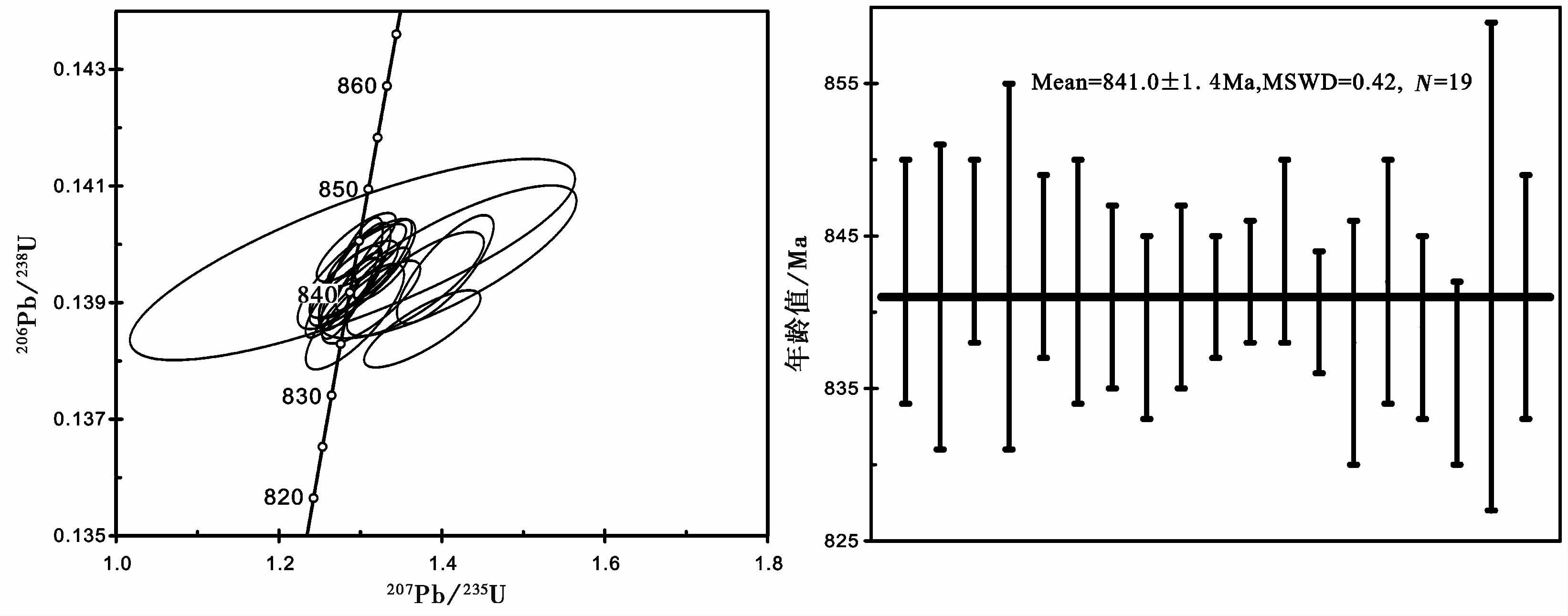
|
图5 蚀变流纹岩锆石LA-ICP-MS U-Pb谐和图 Fig.5 Zircon LA-ICP-MS U-Pb ages of the metarhyolite |
对已获得U-Pb年龄的19粒锆石进行原位LA-MC-ICP-MS锆石Hf同位素分析,样品分析点与U-Pb 年龄编号一致(表 3)。176Lu/177 Hf比值为0.000037~0.000948,176Lu/177 Hf比值均小于0.002,表明锆石在形成以后有极少的放射成因Hf的积累,因而可以用初始176 Hf/177 Hf比值代表锆石形成时的176 Hf/177 Hf比值(吴福元等,2007)。用锆石U-Pb年龄计算的Hf 同位素初始比值176 Hf/177 Hf(t)和εHf(t)分别为0.281 423~0.281 983和-29~-9。单阶段模式年龄TDM(Hf)为1.69~2.41Ga,TDM2(Hf)二阶段模式年龄为2.24~3.43Ga,由于所测锆石的fLu/Hf=-0.99~-0.97。因此,二阶段模式年龄更能反应其源区物质从亏损地幔被抽取的时间(吴福元等,2007)。
| 表3 蚀变流纹岩锆石Hf同位素分析结果 Table 3 Zircon Hf isotopic data of the metarhyolite |
蚀变流纹岩高Sr(>400×10-6)、低Y(<18×10-6)和Yb(<1.9×10-6)以及高的Sr/Y(>40)和(La/Yb)N(>40)比值,表明它们的地球化学特征类似于埃达克岩(张旗等,2011),在Y-Sr/Y(图 6a)和(La/Yb)N-YbN(图 6b)图解中,所有样品落入埃达克岩区域中,指示该组流纹岩成分相当于埃达克质岩的成分,与库鲁克塔格新元古代中期花岗岩类的特征一致(Zhang et al., 2007;Long et al., 2011;Ge et al., 2014),因此可以使用埃达克岩的成因模型分析本区蚀变流纹岩的成因。目前对于埃达克岩的成因有5个常用的模型,包括:1)俯冲的玄武质大洋板片的部分熔融或板片熔体交代过的地幔楔橄榄岩的部分熔融(Defant and Drummond, 1990;Stern and Kilian, 1996;Martin et al., 2005);2)玄武质岩浆经地壳混染和结晶分异的AFC过程(Macpherson et al., 2006);3)拆沉下部地壳的部分熔融(Kay and Kay, 1993;Xu et al., 2002;Wang et al., 2007);4)岩浆混合(Streck et al., 2007);5)增厚下地壳基性岩石的部分熔融(Chung et al., 2003;Wang et al., 2005)。
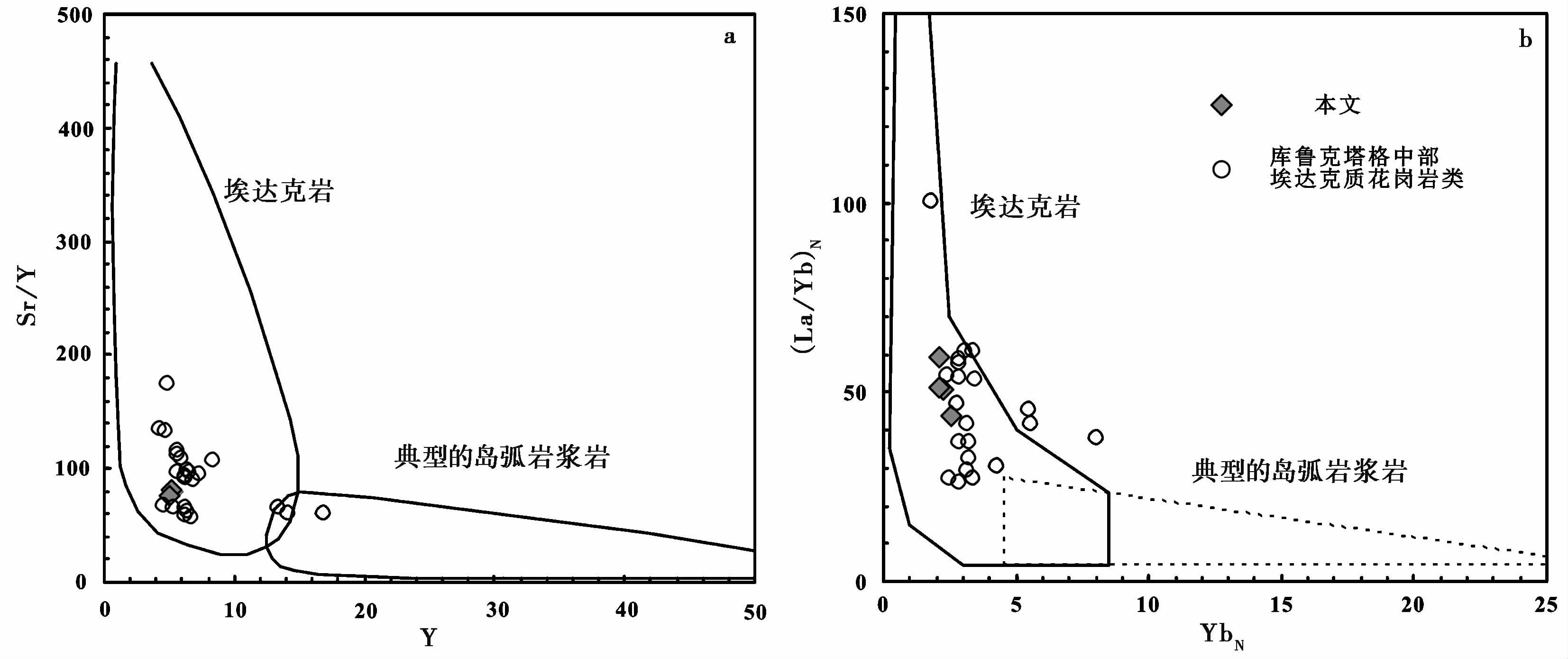
|
图6 蚀变流纹岩Y-Sr/Y图解(a)和(La/Yb)N-YbN图解(b) Fig.6 Y-Sr/Y diagram(a)and(La/Yb)N-YbN diagram(b)of the metarhyolite |
本区流纹岩具有高的K2O/Na2O比值(0.98~1.25),低MgO(0.59~0.63)和Mg#(34~35)的特征,明显不同于来自俯冲板片或上覆地幔楔熔融的埃达克岩(Martin et al., 2005)。拆沉下部地壳熔融形成的埃达克岩浆在其上升过程中与地幔相互作用会导致MgO、Cr、Co和Ni含量的增加(Xu et al., 2002;Wang et al., 2006),本区流纹岩与上述特征明显不同。近期研究揭示母岩浆为玄武质的岩浆经地壳混染和结晶分异过程形成地幔来源的原始埃达克质岩浆,在地球化学和同位素组成上会显示出明显系统的变化,并且在角闪石、单斜辉石等基性矿物中通常会发育成分环带(Castillo et al., 1999),在蚀变流纹岩中未见角闪石和单斜辉石等暗色矿物,且在La/Sm-Sm图解(图 7a)和(La/Yb)N-La图解(图 7b)中未显示分离结晶的趋势,因此不支持其来自玄武质岩浆经地壳混染和结晶分异的AFC过程。岩石高硅的特征及简单的矿物组成,并且在野外未见基性包体,这些特征表明岩浆混合作用同样不能解释本区埃达克岩的成因。故本区流纹岩极有可能来自增厚下地壳基性岩石的部分熔融。此外蚀变流纹岩具富钾的特征,这与张旗(2011)提出的C型埃达克岩的特征一致,而C型埃达克岩通常被认为是是加厚下地壳底部的中基性岩部分熔融的产物。研究表明,具有低的176 Hf/177 Hf以及εHf(t)值表明花岗岩可能来源于古老地壳的深熔或重熔(Kinny and Maas, 2003);具有较高的176 Hf/177 Hf以及εHf(t)值表明花岗岩可能来源于新生地壳的再循环或大陆地壳中新生地幔物质的混入(Jahn et al., 2000)。本文蚀变流纹岩锆石Hf同位素数据显示,其具有非常负的εHf(t)值(-29~-9),在εHf(t)-t图解(图 8)上,这些锆石的Hf同位素位于库鲁克塔格地区古元古代基底演化范围,指示为古老下地壳物质重熔的产物。
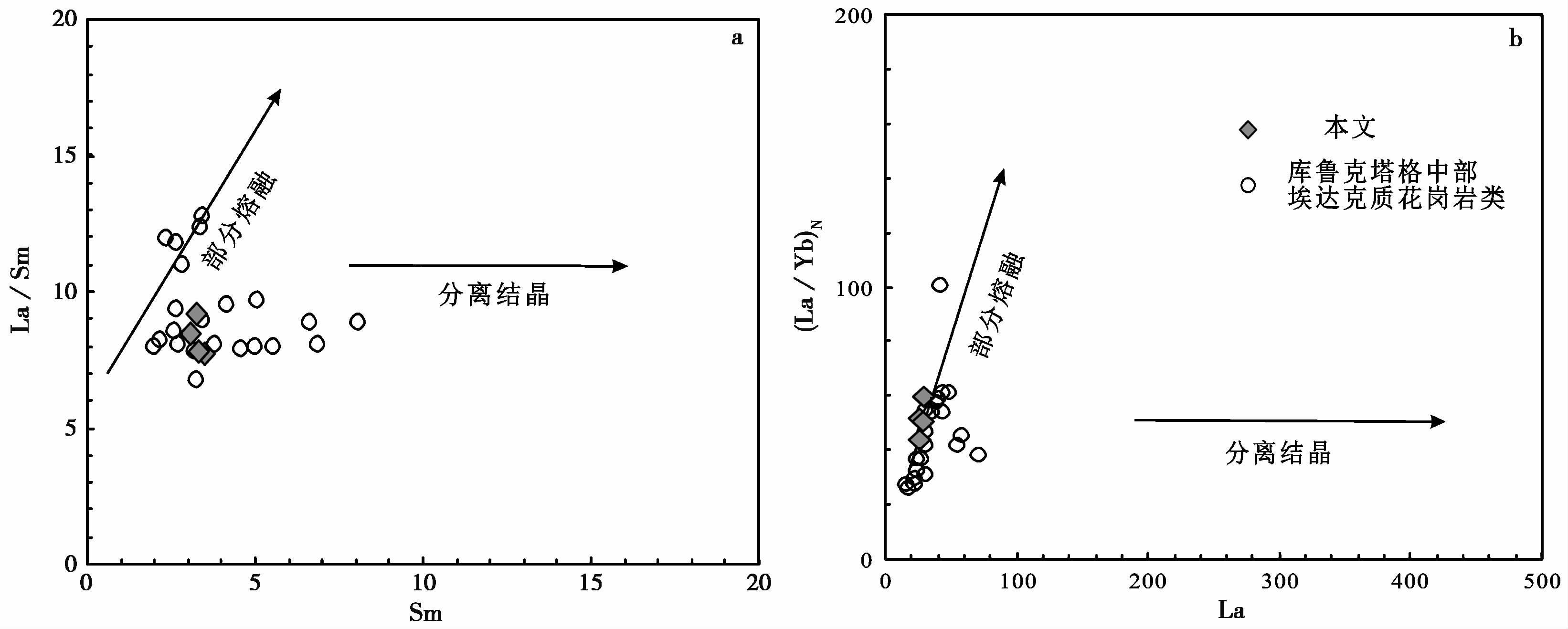
|
图7 蚀变流纹岩La/Sm-Sm图解(a)和(La/Yb)N-La图解(b) 库鲁克塔格中部埃达克质花岗岩数据同 图 3 Fig.7 La/Sm-Sm diagram(a)and(La/Yb)N-La diagram(b)of the metarhyolite |
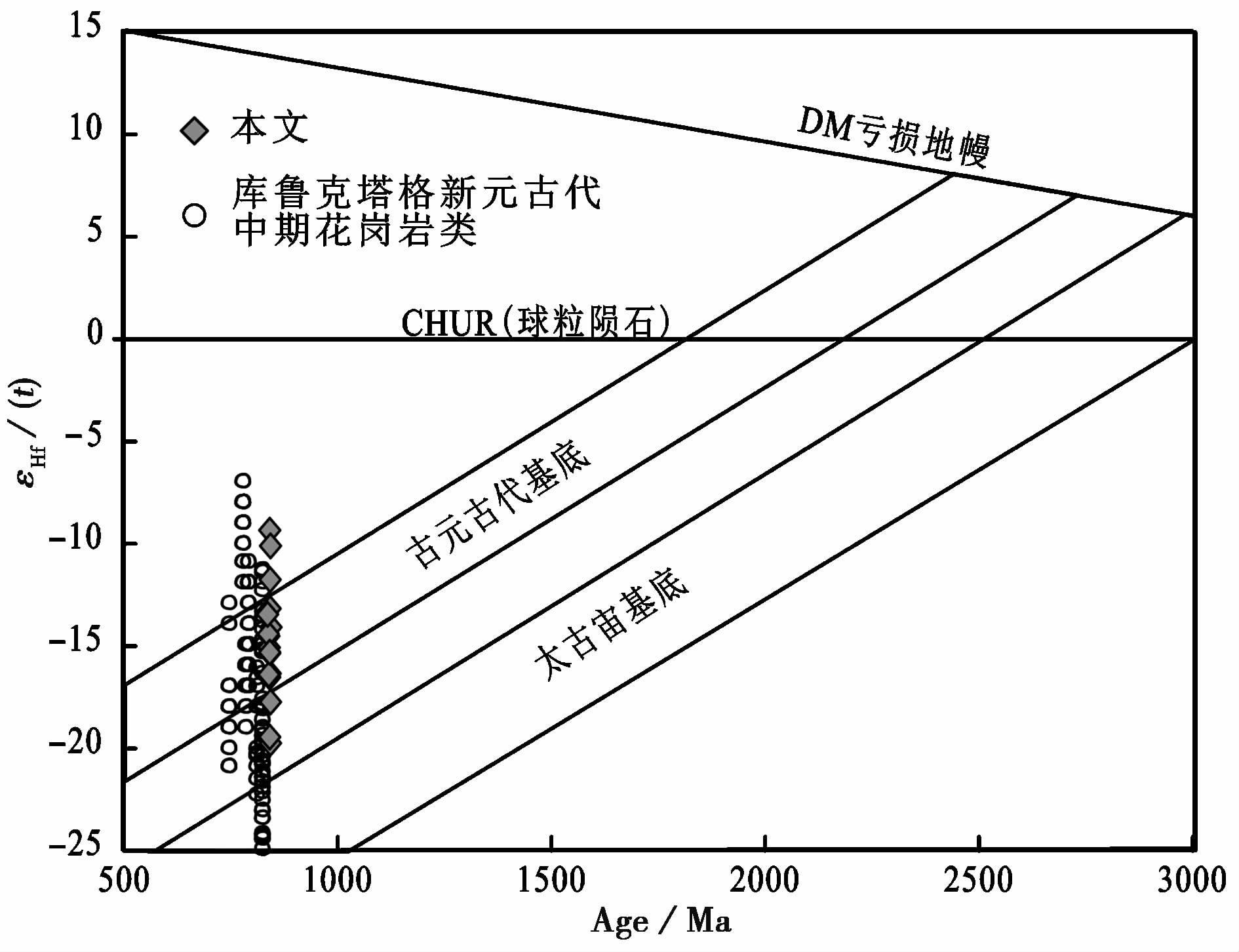
|
图8 蚀变流纹岩年龄-εHf(t)图解 太古宙及古元古代基底演化区域据Long et al., 2010;库鲁克塔格新元古代中期花岗岩据Zhang et al., 2007;Long et al., 2011;Ge et al., 2014 Fig.8 Age-εHf(t)diagram of the metarhyolite |
库鲁克塔格地区新元古代中期发育大量的埃达克质花岗岩类(Zhang et al., 2007;罗新荣,2008;Long et al., 2011;Ge et al., 2014),它们的地球化学特征和古老的Hf同位素二阶段模式年龄,结合塔里木北缘存在太古宙基底,这些花岗岩类被认为是自增厚古老基性下地壳的部分熔融(Zhang et al., 2007;Long et al., 2011)。蚀变流纹岩形成时代、地球化学特征以及Hf同位素特征与库鲁克塔格发育的埃达克质花岗岩类相似,暗示它们具相似的成因。蚀变流纹岩高Sr、Eu的正异常以及极度亏损重稀土的特征表明其源区存在石榴石的稳定残留以及不含斜长石(Defant and Drummond, 1990;Rapp et al., 2003)。
由于锆石是花岗岩中结晶最早的矿物之一,锆石饱和温度计可以用来限制岩浆的初始温度(Watson and Harrison, 1983;Hanchar and Watson, 2003)。本区流纹岩锆石饱和温度平均为765℃,库鲁克塔格西部约830Ma的花岗闪长岩锆石饱和温度为770℃(Ge et al., 2014),库鲁克塔格中、东部826~785Ma花岗岩(Zhang et al., 2007,2012;Cao et al., 2011;Long et al., 2011)具有更低的TZr(平均分别为764℃和715℃),这些样品中继承锆石的普遍存在表明初始岩浆是锆石过饱和的(Miller et al., 2003),因此上述仅是初始岩浆温度的最大值,说明该期花岗岩的初始岩浆温度远远低于基性岩(斜长角闪岩/榴辉岩)的脱水熔融温度(至少800℃~850℃)(Qian and Hermann, 2013),因此这些花岗岩类可能是由外来流体加入导致的低温熔融的产物,而不是外来热的加入引起的脱水熔融(Miller et al., 2003)。
综合以上分析,本区蚀变流纹岩形成于加厚的基性下地壳在流体加入的条件下低温部分熔融的产物,指示库鲁克塔格该时期存在一次地壳加厚事件。
7 地质意义 7.1 时代意义前人对北塞纳尔塔格组的形成时代主要依赖该组中叠层石的形成时代,仅提供了大致的沉积时限,不能提供准确的年龄数据,该组新发现火山岩产于白云岩顶部,定年结果表明蚀变流纹岩形成时间为841.0±1.4Ma,属青白口系,与前人化石资料的时代基本一致。前人资料表明库鲁克塔格北塞纳尔塔格组为一套碳酸盐岩沉积,无火山岩记录,蚀变流纹岩的发现,表明塔里木北缘新元古中期除了大量的侵入岩外,还存在火山活动。
7.2 构造意义本区岩石富集大离子亲石元素(LILE)和轻稀土元素(LREE),Nb、Ta、Ti的负异常明显,整体特征类似于弧火山岩,在Nb-Y和Rb-(Y+Nb)构造判别图解中,本文所研究样品均落入火山弧花岗岩范围内(图 9),指示火山岩具弧岩浆岩的特点。此外岩石地球化学特征及Hf同位素特征表明,本区蚀变流纹岩形成于加厚的基性下地壳在流体加入的条件下低温部分熔融,这一形成过程更有可能发生在与俯冲有关的构造背景。
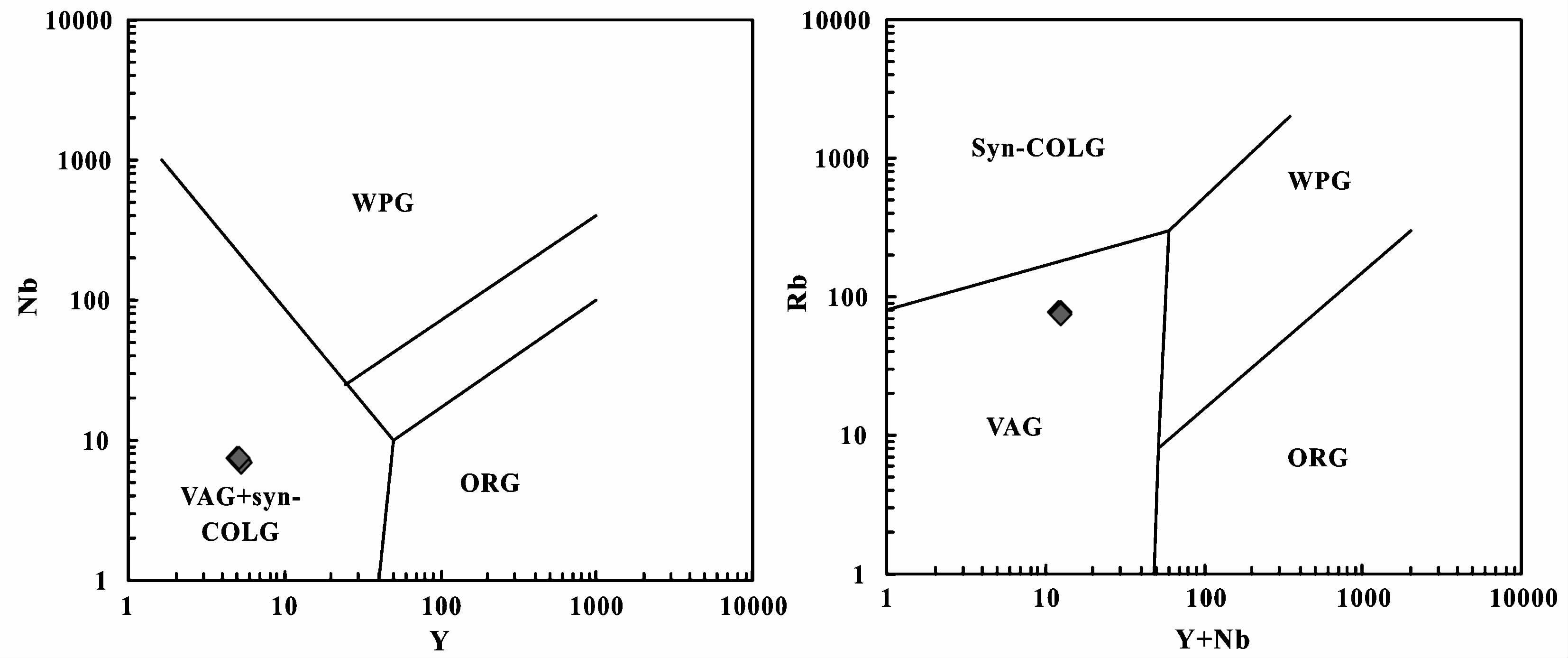
|
图9 蚀变流纹岩Nb-Y和Rb-(Y+Nb)构造判别图解 WPG. 板块内部型;syn-COLG. 同碰撞型;VAG. 火山弧型;ORG. 洋中脊型 Fig.9 Tectonic discrimination diagrams of Y-Nb and Rb-(Y+Nb)of the metarhyolite |
对于塔里木克拉通北缘存在大量的新元古代中晚期广泛而多样化的岩浆活动,最为普遍的观点认为这些岩石是Rodinia超大陆裂解有关的多期地幔柱活动和大陆裂谷作用的产物(Xu et al., 2005,2009;Zhang et al., 2007;Lu et al., 2008;Zhang et al., 2009,Hu et al., 2010;Long et al., 2011;Shu et al., 2011;Zhang et al., 2013)。然而到目前为止,塔里木北缘仍未发现新元古代地幔柱作用的直接证据,如科马提岩或高镁玄武岩、大陆溢流玄武岩、OIB等;且该区新元古代中期岩浆岩以太古代基性下地壳重熔产生的花岗岩为主,地幔物质贡献非常有限;仅少量存在的基性—超基性—火成碳酸杂岩常被认为是地幔柱作用的产物,但是这些岩石均富集LREE和LILE,亏损Nb、Ta、Ti,因此是交代岩石圈地幔或软流圈地幔部分熔融的产物,其触发因素可能是俯冲相关的流体/熔体,而非地幔柱相关的热。因此地幔柱模型不能很好地解释本区岩石组合及成因。
Ge et al.(2014)指出,库鲁克塔格地区大面积830~780Ma的花岗岩大多来自于太古宙基性下地壳的低温含水的部分熔融,大面积分布的低温花岗岩形成要求大量外来流体的加入,而俯冲板片的脱水和含水基性岩的底侵是最有效的下地壳供水机制,因此该区大面积的花岗岩可以更好地解释为大陆岛弧岩浆作用。此外,关于塔里木北缘新元古代的构造背景长期存有争论,主要归结于对具有指示性意义的阿克苏蓝片岩相(高压—低温)变质事件的定年困难和疑问。近期,张健等(2014)对阿克苏蓝片岩碎屑锆石的分析,将阿克苏蓝片岩相变质的时间被严格限定在820~760Ma区间内,表明塔里木新元古代洋壳的俯冲可能持续到760Ma。Ge et al.(2014)认为,塔里木克拉通可能位于Rodina超大陆的外围,其北缘在新元古代早-中期可能面临一个宽阔的大洋盆。因此本区蚀变流纹岩很有可能形成于与俯冲相关的大陆弧环境。
综上所述,本文认为,在新元古早-中期,塔里木北缘洋—陆俯冲碰撞作用导致塔里木北缘陆壳加厚,俯冲洋壳释放流体导致加厚古老的基性下地壳及上覆地幔楔发生部分熔融,形成本区约840Ma的流纹岩和830~780Ma大量具埃达克岩地球化学特征的花岗岩以及少量的超基性—基性岩;He et al.(2012)对库鲁克塔格地区新元古代麻粒岩的研究得到820~790Ma的变质年龄;Ge et al.(2013)发现在库尔勒地区存在约830Ma的深熔作用与高角闪岩相至高压麻粒岩相叠加作用也均为此次洋—陆俯冲碰撞作用的产物。
8 结 论(1) 运用LA-ICP-MS锆石U-Pb测年获得库鲁塔格西段西山口地区蚀变流纹岩的形成时代为841.0±1.4Ma,为青白口纪晚期。
(2) 蚀变流纹岩地球化学特征类似于埃达克岩,其形成于加厚古老基性下地壳的低温部分熔融。
(3) 结合区域地质资料,初步认为蚀变流纹岩形成与塔里木北缘新元古代早-中期洋—陆俯冲碰撞作用有关。
| [1] | 蔡土赐. 1999. 新疆维吾尔自治区岩石地层. 武汉: 中国地质大学出版社. 1-430. |
| [2] | Cai Tuci. 1999. Lithostratigraphy of Xinjiang Uygur Autonomous Region. Wuhan: China University of Geosciences Press. 1-430. |
| [3] | 邓兴梁, 舒良树, 朱文斌等. 2008. 新疆兴地断裂带前寒武纪构造-岩浆-变形作用特征及其年龄. 岩石学报,24 (12): 2800-2808. |
| [4] | Deng Xingliang, Shu Liangshu, Zhu Wenbin et al. 2008. Precambrian tectonism, magmatiam, deformation and geochronology of igneous rocks in the Xingdi fault zone, Xinjiang. Acta Petrologica Sinica,24 (12): 2800-2808. |
| [5] | 冯本智, 周裕文, 迟仕福等. 1995. 新疆库鲁克塔格地区前震旦纪地质与贵重、 有色金属矿床. 北京: 地质出版社. 1-282. |
| [6] | Feng Benzhi, Zhou Yuwen, Chi Shifu et al. 1995. Presinian Geology, Precious and Non-Ferouxinks Metal Deposits in Kuruktag Area, Xinjiang Uygur Autonomous Region, China. Beijing: Geological Publishing House. 1-282. |
| [7] | 郭瑞清, 秦切, 木合塔尔·扎日等. 2013. 新疆库鲁克塔格西段奥陶纪花岗岩体地质特征及构造意义. 地学前缘,20 (4): 251-263. |
| [8] | Guo Ruiqing, Qin Qie, Muhetaer Zari et al. 2013. Geological characteristics and tectonic significance of Ordovician granite intrusions in the western segment of Quruqtagh, Xinjiang. Earth Science Frontiers,20 (4): 251-263. |
| [9] | 侯可军, 李延河, 邹天人等. 2007. LA-MC-ICP-MS 锆石Hf同位素的分析方法及地质应用. 岩石学报,13 (10): 2595-2604. |
| [10] | Hou Kejun, Li Yanhe, Zou Tianren et al. 2008. Laser ablation-MC-ICP-MS technique for Hf isotope microanalysis of zircon and its geological application. Acta Petrologica Sinica,13 (10): 2595-2604. |
| [11] | 胡霭琴, 韦刚健, 江博明等. 2010. 天山0. 9Ga 新元古代花岗岩 SHRIMP锆石U-Pb 年龄及其构造意义.地球化学,39 (3): 197-212. |
| [12] | Hu Aiqin, Wei Gangjian, Jiang Boming et al. 2010. Formation of the 0.9Ga Neoproterozoic granitoids in the Tianshan orogen, NW China: Constraints from the SHRIMP zircon age determination and its tectonic significance. Geochimica,39 (3): 197-212. |
| [13] | 贾晓亮, 郭瑞清, 柴凤梅等. 2013. 新疆库鲁克塔格西段泥盆纪二长花岗岩年龄、 地球化学特征及其构造意义. 地质通报,32 (2): 239-250. |
| [14] | Jia Xiaoliang, Guo Ruiqing, Chai Fengmei et al. 2013. Geochemistry and geochronology of monzogranites in Kuruktag of Xinjiang and their tectonic implications. Geological Bulletin of China,32 (2): 239-250. |
| [15] | 李怀坤, 耿建珍, 郝爽等. 2009. 用激光烧蚀多接收器等离子体质谱仪(LA-MC-ICPMS)测定锆石 U-Pb 同位素年龄的研究. 矿物学报,29 (增刊): 600-601. |
| [16] | Li Huaikun, Gen Jianzhen, Hao Shuang et al. 2009. Research on the dating zircon U-Pb age by LA-MC-ICPMS. Acta Mineralogica Sinica,29 (suppl.): 600-601. |
| [17] | 罗新荣, 石福品, 樊卫东等. 2008. 新疆库鲁克塔格新元古代花岗岩年龄和地球化学. 资源调查与环境,28 (4): 235-241. |
| [18] | Luo Xinrong, Shi Fuping, Fan Weidong et al. 2008. Age and geochemistry of Neoproterozoic granite from Kuruketage in the north of Tarim, Xinjiang. Resourse Survey and Environment,28 (4): 235-241. |
| [19] | 尼加提, 郭瑞清, 帕拉提等. 2013. 新疆库鲁克塔格阿訇开里得南石炭纪花岗岩 LA-ICP-MS锆石 U-Pb定年及其地质意义. 地质通报,32 (2): 251-259. |
| [20] | Nijiati, Guo Ruiqing, Palati et al. 2013. Zircon LA-ICP-MS U-Pb dating of South Ahongkailide Carbonifereous granite in Kuruktag of Xinjiang and its geological implications. Geological Bulletin of China,32 (2): 251-259. |
| [21] | 吴福元, 李献华, 郑永飞等. 2007. Lu-Hf 同位素体系及其岩石学应用. 岩石学报,23 (2): 185-220. |
| [22] | Wu Fuyuan, Li Xianhua, Zheng Yongfeng et al. 2007. Lu-Hfisotopic systematics and their applications in petrology. Acta Petrologica Sinica,23 (2): 185-220. |
| [23] | 吴元保, 陈道公, 夏群科等. 2002. 大别山黄镇榴辉岩锆石的微区微量元素分析: 榴辉岩相变质锆石的微量元素特征. 科学通报,47 (11): 859-863. |
| [24] | Wu Yuanbao, Chen Daogong, Xia Qunke et al. 2002. In-situ trace element analyses of zircons from Dabieshan Huangzhen eclogite: Trace element characteristics of eclogite-facies metamorphic zircon. Chinese Science Bulletin,47 (16): 1398-1401. |
| [25] | 吴元保, 郑永飞. 2004. 锆石成因矿物学研究及其对 U-Pb 年龄解释的制约. 科学通报,49 (16): 1589-1604. |
| [26] | Wu Yuanbao and Zheng Yongfei. 2004. Genesis of zircon and its constraints on interpretation of U-Pb age. Chinese Science Bulletin,49 (15): 1554-1569. |
| [27] | 张传林, 叶现韬, 李怀坤. 2014. 新疆塔里木北缘新元古代最晚期岩浆事件. 地质通报,33 (5): 606-613. |
| [28] | Zhang Chuanlin, Ye Xiantao and Li Huaikun. 2014. The latest Neoproterozoic igneous activity on the northern margin of the Tarim Craton. Geological Bulletin of China,33 (5): 606-613. |
| [29] | 张健, 张传林, 李怀坤等. 2014. 再论塔里木北缘阿克苏蓝片岩的时代和成因环境: 来自锆石 U-Pb 年龄, Hf 同位素的新证据. 岩石学报,30 (11): 3357-3365. |
| [30] | Zhang Jian, Zhang Chuanlin, Li Huaikun et al. 2014. Revisit to time and tectonic environment of the Aksu blueschist terrane in northern Tarim, NW China: New evidence from zircon U-Pb age and Hf isotope. Acta Petrologica Sinica,30 (11): 3357-3365. |
| [31] | 张旗, 王焰, 钱青等. 2001. 中国东部燕山期埃达克岩的特征及其构造-成矿意义. 岩石学报,17 (2): 236-244 . |
| [32] | Zhang Qi, Wang Yan, Qian Qing et al. 2001. The characteristics and tectonic-metallogenic significances of the adakites in Yanshan period from eastern China. Acta Petrologica Sinica,17 (2): 236-244. |
| [33] | 张旗, 2011. 关于C 型埃达克岩成因的再探讨. 岩石矿物学杂志,30 (4): 739-747. |
| [34] | Zhang Qi. 2011. Reappraisal of the origin of C-type adakitic rocks from East China. Acta Petrologica et Mineralogica,30 (4): 739-747. |
| [35] | Albarède F, Scherer E E, Blichert-Toft J et al. 2006. γ-ray irradiation in the early solar system and the conundrum of the 176 Lu decay constant. Geochimica et Cosmochimica Acta,70 (5): 1261-1270. |
| [36] | Andersen T. 2002. Correction of common lead in U-Pb analyses that do not report 204 Pb. Chemical Geology,192 (1): 59-79. |
| [37] | Bouvier A, Vervoort J D and Patchett P J. 2008. The Lu-Hf and Sm-Nd isotopic composition of CHUR: Constraints from unequilibrated chondrites and implications for the bulk composition of terrestrial planets. Earth and Planetary Science Letters,273 (1): 48-57. |
| [38] | Cao X F, Lü X B, Liu S T et al. 2011. LA-ICP-MS zircon dating, geochemistry, petrogenesis and tectonic implications of the Dapingliang Neoproterozoic granites at Kuluketage block, NW China. Precambrian Research,186 (1): 205-219. |
| [39] | Castillo P R, Janney P E and Solidum R U. 1999. Petrology and geochemistry of Camiguin Island, southern Philippines: Insights to the source of adakites and other lavas in a complex arc setting. Contributions to Mineralogy and Petrology,134 (1): 33-51. |
| [40] | Chu N C, Taylor R N, Chavagnac V et al. 2002. Hf isotope ratio analysis using multi-collector inductively coupled plasma mass spectrometry: An evaluation of isobaric interference corrections. Journal of Analytical Atomic Spectrometry,17 (12): 1567-1574. |
| [41] | Chung S L, Liu D Y, Ji J Q et al. 2003. Adakites from continental collision zones: Melting of thickened lower crust beneath southern Tibet. Geology,31 (11): 1021-1024. |
| [42] | Defant M J and Drummond M S. 1990. Derivation of some modern arc magmas by melting of young subducted lithosphere. Nature,347 (6294): 662-665. |
| [43] | Evans D A. 2009. The palaeomagnetically viable, long-lived and all-inclusive Rodinia supercontinent reconstruction. Geological Society, London, Special Publications,327 (1): 371-404. |
| [44] | Ge R F, Zhu W B, Zheng B H et al. 2012. Early Pan-African magmatism in the Tarim Craton: Insights from zircon U-Pb-Lu-Hf isotope and geochemistry of granitoids in the Korla area, NW China. Precambrian Research,212 - 213 : 117-138. |
| [45] | Ge R F, Zhu W B, Wu H L et al. 2013. Zircon U-Pb ages and Lu-Hf isotopes of Paleoproterozoic metasedimentary rocks in the Korla complex, NW China: Implications for metamorphic zircon formation and geological evolution of the Tarim Craton. Precambrian Research,231 (5): 1-18. |
| [46] | Ge R F, Zhu W B, Wilde S A et al. 2014. Neoproterozoic to Paleozoic long-lived accretionary orogeny in the northern Tarim Craton. Tectonics,33 (3): 302-329. |
| [47] | Griffin W, Pearson N J, Belousova E et al. 2000. The Hf isotope composition of cratonic mantle: LAM-MC-ICPMS analysis of zircon megacrysts in kimberlites. Geochimica et Cosmochimica Acta,64 (1): 133-147. |
| [48] | Guo Z J, Yin A, Robinson A et al. 2005. Geochronology and geochemistry of deep-drill-core samples from the basement of the central Tarim Basin. Journal of Asian Earth Sciences,25 (1): 45-56. |
| [49] | Hanchar J M and Watson E B. 2003. Zircon saturation thermometry. Reviews in Mineralogy and Geochemistry,53 (1): 89-112 . |
| [50] | Hastie A R, Kerr A C, Pearce J A et al. 2007. Classification of altered volcanic island arc rocks using immobile trace elements: Development of the Th-Co discrimination diagram. Journal of Petrology,48 (12): 2341-2357. |
| [51] | He J, Zhu W and Ge R F. 2014a. New age constraints on Neoproterozoic diamicites in Kuruktag, NW China and Precambrian crustal evolution of the Tarim Craton. Precambrian Research,241 : 44-60. |
| [52] | He J, Zhu W, Ge R F et al. 2014b.Detrital zircon U-Pb ages and Hf isotopes of Neoproterozoic strata in the Aksu area, northwestern Tarim Craton: Implications for supercontinent reconstruction and crustal evolution. Precambrian Research,254 : 194-209. |
| [53] | He Z Y, Zhang Z M, Zong K Q et al. 2012. Neoproterozoic granulites from the northeastern margin of the Tarim Craton: Petrology, zircon U-Pb ages and implications for the Rodinia assembly. Precambrian Research,212 : 21-33. |
| [54] | Hidaka H, Shimizu H and Adachi M. 2002. U-Pb geochronology and REE geochemistry of zircons from Palaeoproterozoic paragneiss clasts in the Mesozoic Kamiaso conglomerate, central Japan: Evidence for an Archean provenance. Chemical Geology,187 (3): 279-93. |
| [55] | Hoffman P F. 1991. Did the breakout of Laurentia turn Gondwanaland inside-out. Science,252 (5011): 1409-1412. |
| [56] | Hu A Q, Jahn B M, Zhang G et al. 2000. Crustal evolution and Phanerozoic crustal growth in northern Xinjiang: Nd isotopic evidence. PartⅠ . Isotopic characterization of basement rocks.Tectonophysics,328 (1): 15-51. |
| [57] | Jahn B M, Wu F and Hong D. 2000. Important crustal growth in the Phanerozoic: Isotopic evidence of granitoids from east-central Asia. Journal of Earth System Science,109 (1): 5-20. |
| [58] | Kay R W and Kay S M. 1993. Delamination and delamination magmatism. Tectonophysics,219 (1): 177-189. |
| [59] | Kinny P D and Maas R. 2003. Lu-Hf and Sm-Nd isotope systems in zircon. Reviews in Mineralogy and Geochemistry,53 (1): 327-341. |
| [60] | Li Z X, Bogdanova S, Collins A et al. 2008. Assembly, configuration, and break-up history of Rodinia: A synthesis. Precambrian Research,160 (1): 179-210. |
| [61] | Liu Y S, Hu Z C, Zong K Q et al. 2010. Reappraisement and refinement of zircon U-Pb isotope and trace element analyses by LA-ICP-MS. Chinese Science Bulletin,55 (15): 1535-1546. |
| [62] | Long X P, Yuan C, Sun M et al. 2010. Archean crustal evolution of the northern Tarim Craton, NW China: Zircon U-Pb and Hf isotopic constraints. Precambrian Research,180 (3-4): 272-284. |
| [63] | Long X P, Yuan C, Sun M et al. 2011. Reworking of the Tarim Craton by underplating of mantle plume-derived magmas: Evidence from Neoproterozoic granitoids in the Kuluketage area, NW China. Precambrian Research,187 (1): 1-14. |
| [64] | Lu S, Li H, Zhang C et al. 2008. Geological and geochronological evidence for the Precambrian evolution of the Tarim Craton and surrounding continental fragments. Precambrian Research,160 (1): 94-107. |
| [65] | Ludwig K R. 2003. User's Manual for Isoplot 3. 00: A Geochronological Toolkit for Microsoft Excel. Berkeley: Berkeley Geochronology Center Special Publication.1-74. |
| [66] | Möller A, O'Brien P J, Kennedy A et al. 2003. Linking growth episodes of zircon and metamorphic textures to zircon chemistry: An example from the ultrahigh-temperature granulites of Rogaland(SW Norway). Geological Society, London, Special Publications,220 (1): 65-81. |
| [67] | Macpherson C G, Dreher S T and Thirlwall M F. 2006. Adakites without slab melting: High pressure differentiation of island arc magma, Mindanao, the Philippines. Earth and Planetary Science Letters,243 (3): 581-593. |
| [68] | Martin H, Smithies R, Rapp R et al. 2005. An overview of adakite, tonalite-trondhjemite-granodiorite(TTG), and sanukitoid: Relationships and some implications for crustal evolution. Lithos,79 (1): 1-24. |
| [69] | Miller C F, McDowell S M and Mapes R W. 2003. Hot and cold granites?Implications of zircon saturation temperatures and preservation of inheritance. Geology,31 (6): 529-532. |
| [70] | Qian Q and Hermann J. 2013. Partial melting of lower crust at 10-15 kbar: Constraints on adakite and TTG formation. Contributions to Mineralogy and Petrology,165 (6): 1195-1224. |
| [71] | Rapp R P, Shimizu N and Norman M D. 2003. Growth of early continental crust by partial melting of eclogite. Nature,425 (6958): 605-609. |
| [72] | Rudnick R L and Gao S. 2003. Composition of the continental crust. Treatise on Geochemistry,3 : 1-64. |
| [73] | Shu L S, Deng X L, Zhu W B et al. 2011. Precambrian tectonic evolution of the Tarim block, NW China: New geochronological insights from the Quruqtagh domain. Journal of Asian Earth Sciences,42 (5): 774-790. |
| [74] | Stern C R and Kilian R. 1996. Role of the subducted slab, mantle wedge and continental crust in the generation of adakites from the Andean Austral volcanic zone. Contributions to Mineralogy and Petrology,123 (3): 263-281. |
| [75] | Streck M J, Leeman W P and Chesley J. 2007. High-magnesian andesite from Mount Shasta: A product of magma mixing and contamination, not a primitive mantle melt. Geology,35 (4): 351-354. |
| [76] | Tomaschek F, Kennedy A K, Villa I M et al. 2003. Zircons from Syros, Cyclades, Greece-recrystallization and mobilization of zircon during high-pressure metamorphism. Journal of Petrology,44 (11): 1977-2002. |
| [77] | Wang Q, McDermott F, Xu J F et al. 2005. Cenozoic K-rich adakitic volcanic rocks in the Hohxil area, northern Tibet: Lower-crustal melting in an intracontinental setting. Geology,33 (6): 465-478. |
| [78] | Wang Q, Xu J F, Jian P et al. 2006. Petrogenesis of adakitic porphyries in an extensional tectonic setting, Dexing, South China: Implications for the genesis of porphyry copper mineralization. Journal of Petrology,47 (1): 119-144. |
| [79] | Wang Q, Wyman D A, Xu J F et al. 2007. Early Cretaceous adakitic granites in the northern Dabie complex, central China: Implications for partial melting and delamination of thickened lower crust. Geochimica et Cosmochimica Acta,71 (10): 2609-2636. |
| [80] | Watson E B and Harrison T M. 1983. Zircon saturation revisited: Temperature and composition effects in a variety of crustal magma types. Earth and Planetary Science Letters,64 (2): 295-304. |
| [81] | Wen B, Li Y X and Zhu W B. 2013. Paleomagnetism of the Neoproterozoic diamictites of the Qiaoenbrak Formation in the Aksu area, NW China: Constraints on the paleogeographic position of the Tarim block. Precambrian Research,226 : 75-90. |
| [82] | Wu C Z, Santosh M, Chen Y J et al. 2014. Geochronology and geochemistry of Early Mesoproterozoic meta-diabase sills from Quruqtagh in the northeastern Tarim Craton: Implications for breakup of the Columbia supercontinent. Precambrian Research,241 : 29-43. |
| [83] | Xu B, Jian P, Zheng H et al. 2005. U-Pb zircon geochronology and geochemistry of Neoproterozoic volcanic rocks in the Tarim block of Northwest China: Implications for the breakup of Rodinia supercontinent and Neoproterozoic glaciations. Precambrian Research,136 (2): 107-123. |
| [84] | Xu B, Xiao S, Zou H et al. 2009. SHRIMP zircon U-Pb age constraints on Neoproterozoic Quruqtagh diamictites in NW China. Precambrian Research,168 (3): 247-258. |
| [85] | Xu J F, Shinjo R, Defant M J et al. 2002. Origin of Mesozoic adakitic intrusive rocks in the Ningzhen area of East China: Partial melting of delaminated lower continental crust. Geology,30 (12): 1111-1124. |
| [86] | Zhang C L, Li X H, Li Z X et al. 2007. Neoproterozoic ultramafic-mafic-carbonatite complex and granitoids in Quruqtagh of northeastern Tarim block, western China: Geochronology, geochemistry and tectonic implications. Precambrian Research,152 (3): 149-169. |
| [87] | Zhang C L, Li Z X, Li X H et al. 2009. Neoproterozoic mafic dyke swarms at the northern margin of the Tarim block, NW China. Journal of Asian Earth Sciences,35 (2): 167-179. |
| [88] | Zhang C L, Yang D S, Wang H Y et al. 2011. Neoproterozoic mafic-ultramafic layered intrusion in Quruqtagh of northeastern Tarim block, NW China: Two phases of mafic igneous activity with different mantle sources. Gondwana Research,19 (1): 177-190. |
| [89] | Zhang C L, Zou H B, Wang H Y et al. 2012. Multiple phases of the Neoproterozoic igneous activity in Quruqtagh of the northeastern Tarim block, NW China: Interaction between plate subduction and mantle plume. Precambrian Research,222 - 223 : 488-502. |
| [90] | Zhang C L, Zou H B, Li H K et al. 2013. Tectonic framework and evolution of the Tarim block in NW China. Gondwana Research,23 (4): 1306-1315. |
| [91] | Zhao G C and Cawood P A. 2012. Precambrian geology of China. Precambrian Research,222 - 223 : 13-54. |
| [92] | Zhu W B, Zhang Z Y, Shu L S et al. 2008. SHRIMP U-Pb zircon geochronology of Neoproterozoic Korla mafic dykes in the northern Tarim block, NW China: Implications for the long-lasting breakup process of Rodinia. Journal of the Geological Society,165 : 887-890. |
| [93] | Zhu W B, Zheng B H, Shu L S et al. 2011. Geochemistry and SHRIMP U-Pb zircon geochronology of the Korla mafic dykes: Constrains on the Neoproterozoic continental breakup in the Tarim block, northwest China. Journal of Asian Earth Sciences,42 (5): 791-804 . |
 2016, Vol. 51
2016, Vol. 51


